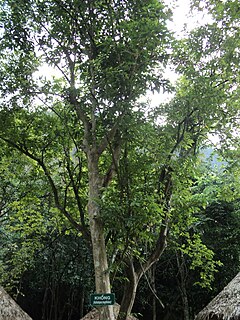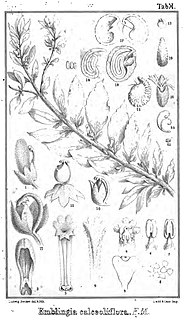
Vernicia, commonly referred to as tung or tung-oil tree, is a genus in the spurge family Euphorbiaceae, first described as a genus in 1790. It is native to China, Japan, India, and Indochina. The species have often been included within the related genus Aleurites.
Rockinghamia is a plant genus of the spurge family (Euphorbiaceae), first described as a genus in 1966. The entire genus is endemic to the State of Queensland in Australia.
- Rockinghamia angustifolia(Benth.) Airy Shaw
- Rockinghamia brevipesAiry Shaw

Koilodepas is a genus of plant of the family Euphorbiaceae first described as a genus in 1856. It is native to Southeast Asia, India, Hainan, and New Guinea.
Cephalomappa is a genus of plant of the family Euphorbiaceae first described as a genus in 1874. It is native to Malaysia, Borneo, and Sumatra.
- Cephalomappa beccarianaBaill. - Sarawak
- Cephalomappa lepidotulaAiry Shaw - Malaysia, Borneo, Sumatra
- Cephalomappa malloticarpaJ.J.Sm. - Malaysia, Borneo, Sumatra
- Cephalomappa paludicolaAiry Shaw - Sarawak
- Cephalomappa penangensisRidl. - Peninsular Malaysia
Kairothamnus is a genus of plants under the family Picrodendraceae described as a genus in 1980. The only known species is Kairothamnus phyllanthoides, endemic to Morobe Province in Papua New Guinea.
Deutzianthus is a genus of trees, from the family Euphorbiaceae. It was first described as a genus in 1924. They are found in Vietnam, southern China, and Sumatra.
- Deutzianthus thyrsiflorus(Airy Shaw) G.L.Webster - Sumatra
- Deutzianthus tonkinensisGagnep. - Yunnan, Guangxi, Vietnam
Hylandia is a genus of plants, of the family Euphorbiaceae, named in honour of Australian botanist Bernie Hyland, by Herbert K. Airy Shaw.
Myricanthe is a genus of plants in the family Euphorbiaceae first described as a genus in 1980. It has only one known species, Myricanthe discolor, endemic to New Caledonia.
Whyanbeelia is a genus of plants under the family Picrodendraceae described as a genus in 1976.
Stachyandra is a plant genus in the family Picrodendraceae first described as a genus in 1990.

Bischofia is a genus of plants in the Phyllanthaceae first described as a genus in 1827. It is native to southern China, the Indian Subcontinent, Queensland, New Guinea, and various islands of the Pacific. It is the only member of the tribe Bischofieae.
- Bischofia javanicaBlume - S China, Taiwan, Ryukyu Is, Himalayas, India, Bangladesh, Assam, Andaman & Nicobar, Indochina, Malaysia, Indonesia, Philippines, Papuasia, Queensland, Fiji, Niue, Samoa, Tonga, Vanuatu, Cook Is, Society Is
- Bischofia polycarpa(H.Lév.) Airy Shaw - China
Ashtonia is a genus of flowering plant belonging to the family Phyllanthaceae first described as a genus in 1968. It is native to the Malay Peninsula and Borneo.
- Ashtonia excelsa Airy Shaw - Borneo
- Ashtonia praeterita Airy Shaw - S Thailand, W Malaysia

Uapaca is a genus of plant, in the family Phyllanthaceae first described as a genus in 1858. It is the only genus comprised in the subtribe Uapacinae. The genus is native to Africa and Madagascar.
Chorisandrachne, is a genus of plants in the flowering plant family Phyllanthaceae first described as a genus in 1969. It contains only one known species, Chorisandrachne diplosperma, native to southern Thailand.
Actephila is a genus of the family Phyllanthaceae, first described as a genus in 1826. It is one of 8 genera in the tribe Poranthereae, and is most closely related to Leptopus. The name of the genus is derived from two Greek words, akte, "the seashore", and philos, "loving". It refers to a coastal habitat.

Skimmia is a genus of four species of evergreen shrubs and small trees in the Rue family, Rutaceae, all native to warm temperate regions of Asia. The leaves are clustered at the ends of the shoots, simple, lanceolate, 6–21 cm long and 2–5 cm broad, with a smooth margin. The flowers are in dense panicle clusters, each flower small, 6–15 mm diameter, with 4-7 petals. The fruit is red to black, 6–12 mm diameter, a fleshy drupe containing a single seed. All parts of the plant have a pungent aroma when crushed. The botanical name, Skimmia, is a Latinization of shikimi, which is the Japanese name for Illicium religiosum as well as an element in miyama shikimi, the Japanese name for Skimmia japonica.

Emblingia is a monospecific plant genus containing the species Emblingia calceoliflora, a herbaceous prostrate subshrub endemic to Western Australia. It has no close relatives, and is now generally placed alone in family Emblingiaceae.
Sohnsia is a genus of plants in the grass family. The only known species is Sohnsia filifolia, native to the States of San Luis Potosí and Querétaro in northeastern Mexico.
Haplothismia is a genus of myco-heterotrophic plants in family Burmanniaceae, first described as a genus in 1952. There is only one known species, Haplothismia exannulata, endemic to southern India. The plant is mycotrophic, i.e. lacking chlorophyll and obtaining sustenance from fungi in the soil.
Choriceras is a genus of plants in the family Picrodendraceae first described as a genus in 1874.






